Does this mean that we have to convert all our old files and save them at the much larger size if we want to keep using them in the future?
Not necessarily. It all depends on how you plan to view the content. If you want to play them in QT X, iTunes, Quick Look, TV, iPod Touch, iPhone, iPad, etc., then conversion is probably the best way to go. If your system's codec configuration has already been modified for for compatibility with your files and you don't care which player you use, then you can continue to play them in QT 7, MPEG Streamclip, or some other play that relies on your system's codec configuration. If you system configuration is not a consideration (e.g., you don't need to maintain "Pro" codec compatibility), then you can use a third-party player with open source codecs built in like VLC, MPlayerX, NicePlayer, etc.
In any case, even if you prefer to convert your content, you don't have to use conversion options with settings that create "larger" files. Apple has tried to make the conversion process easier for inexperienced users but, in doing so, has removed most access to the settings that allow custom conversions. The only options left to the QT X embedded structures under Mavericks and Yosemite are the service presets. And I'm afraid that, at least under Yosemite, some new problems may have to be corrected. As you may, or may not know, both Mavericks and Yosemite have a "Service" option in the Finder "Context" menu that allows you to "manually" access Lo or Hi MPEG-4 AVC, as well as, ProRes 422 encoding options. (The QT X player normally uses the MPEG-4 AVC Hi quality preset unless the source file is encoded in a video editing compression format like AIC in which case it automatically switches to the ProRes 422 codec.) Thus, you can opt to manually select a Lo quality preset which will produce a smaller file than the settings used by the QT X player. Whether or not the final file is larger or smaller than your original file will depend on the relative efficiency of the source file and its specific encoded data rate.
I personally prefer to custom encode my files using the free HandBrake app—especially in view of certain problems discovered this AM under Yosemite (aspect ratio problems with at least some anamorphic source files) and as long as source files aren't encoded with a proprietary codecs not compatible with HandBrake (e.g., Apple proprietary "Pro" codecs). As for the problem mentioned above, here is an example series for tests made under Yosemite in order to answer this post.
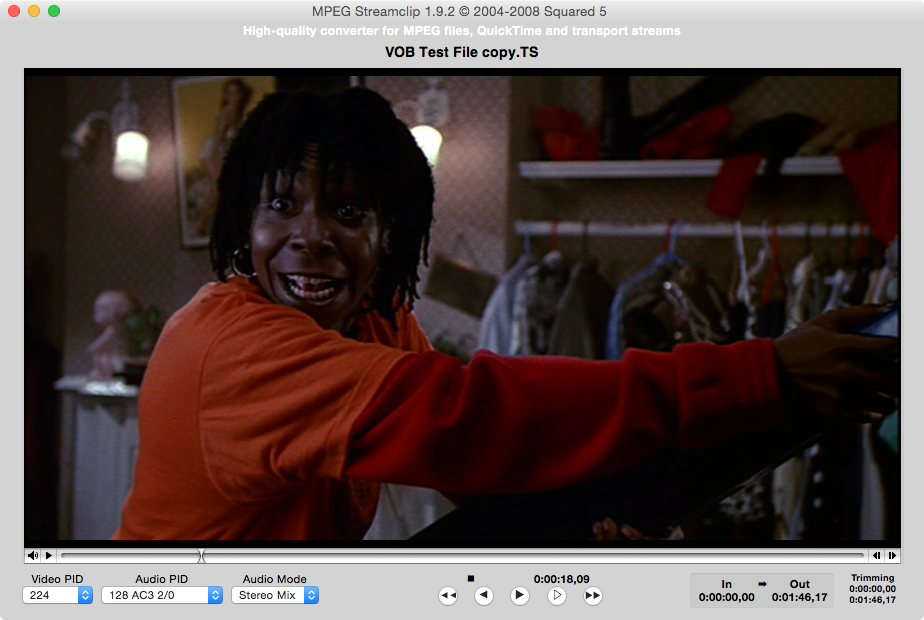

Anamorphic 720x480 (853x480) MPEG2/AC3 source trailer file

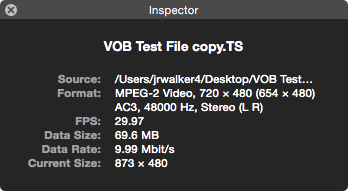
File as opened in QT X Player v1.4 with anamorphic dimensions misread so that when display is rendered in 16:9 window, width is overly scaled upwards and cropped to fit.

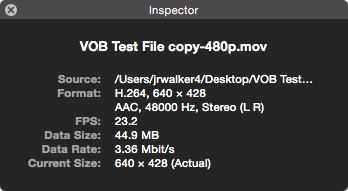
Default output of QT X v1.4 conversion. Note that the originally encoded 720x480 (1.50:1) aspect was incorrectly used for the output and the output aspect was applied to the 640 width to reduce the height to 428 pixels for this supposed 480p conversion.

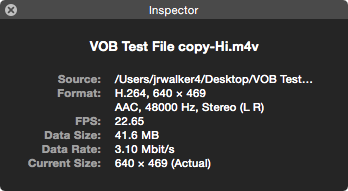
"Service" menu 480p "Hi" quality conversion. Note source aspect ration ignored and output aspect ratio defaulted to approximately 1.33:1 used same approximate target video data rate as the QT X Player conversion.


"Service" menu 480p "Lo" quality conversion. Note that the above aspect problem was duplicated as above but the output aspect problems are different than the earlier one made during the default player conversion. However, you can plainly see that the data rate used for this conversion was roughly half that of the "Hi" conversion depicted immediately above and resulted in a file roughly half the size of the file above.



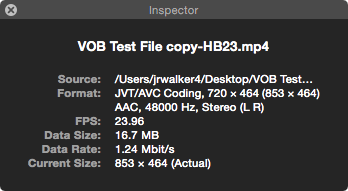
The last set of images are for conversions made by the free HandBrake app. The first pair re for a "normal" quality setting of 20 for my custom encode settings which produced a data rate roughly equal to that of the QT X Lo quality "Service" conversion but maintains a level of quality about equal to that of the QT X Hi "Service" preset. The last pair of images is for an HB custom encode using a quality setting of 23 which renders roughly the same level of quality as the QT X Lo "Service" preset but at only about 60% of its data date and file size. You will also note that this final file output is less than 25% of that of the source file which is a medium efficiency codec compared with the MPEG-4 AVC high efficiency codec.
Are all the different 3rd party add-ons just avoiding the inevitable?
Sorry, I don't really understand your question here. People who don't convert will likely run into an "inevitability" issue later since 2K, 4K, and 8K resolutions and conversions are "just down the road" and codecs just being adopted and coming into use appear to be extensions of the MPEG-4 AVC profile/level family in current use. And, since Apple has already opted to support this family as their default video codec, it is very probably that once QT 7 is dropped, it will not be possible to play any of the legacy formats natively in QT X. However, this doesn't mean that all third-party players will abandon such support. Since my basic workflow starts with content that is normally not natively compatible with QT X, iTunes, QL, TV, mobile device, or Air Video streaming (e.g., BD content, HDV video, etc.), it is just as convenient for me to convert to compatible open formats as it is to convert to incompatible proprietary or out-of-date legacy formats. But this is, of course, a decision to be made by each individual on his or her own depending on their specific needs and requirements.
